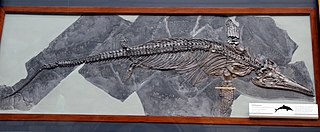
Ichthyosaurs are large extinct marine reptiles. Ichthyosaurs belong to the order known as Ichthyosauria or Ichthyopterygia.

Archosauromorpha is a clade of diapsid reptiles containing all reptiles more closely related to archosaurs rather than lepidosaurs. Archosauromorphs first appeared during the middle Permian, though they became much more common and diverse during the Triassic period.

Léon Louis Vaillant was a French zoologist. He is most famous for his work in the areas of herpetology, malacology, and ichthyology.

Shonisaurus is a very large genus of ichthyosaur. At least 37 incomplete fossil specimens of the marine reptile have been found in the Luning Formation of Nevada, USA. This formation dates to the late Carnian age of the late Triassic period, about 237–227 million years ago.

Ophthalmosaurus is an ichthyosaur of the Jurassic period. Possible remains from the Cretaceous, around 145 million years ago, are also known. Named for its extremely large eyes, it had a 6 metres (20 ft) long dolphin-shaped body with jaws containing many small but robust teeth. Major fossil finds of this genus have been recorded in Europe with a second species possibly being found in North America.

Cetiosaurus meaning 'whale lizard', from the Greek keteios/κήτειος meaning 'sea monster' and sauros/σαυρος meaning 'lizard', is a genus of herbivorous sauropod dinosaur from the Middle Jurassic Period, living about 168 million years ago in what is now Europe.

Erectopus is a basal allosauroid theropod from the Lower Cretaceous of France.

Rachitrema is a poorly known genus of ichthyosaur from the Triassic of France. Its remains were found in France by two independent collectors, towards the end of the nineteenth century. They were only isolated bone fragments.
Platypterygius is a historically paraphyletic genus of platypterygiine ichthyosaur from the Cretaceous period. It was historically used as a wastebasket taxon, and most species within Platypterygius likely are undiagnostic at the genus or species level, or represent distinct genera. While fossils referred to Platypterygius have been found throughout the Early and the beginning of the Late Cretaceous, the holotype specimen was found in Germany.
Californosaurus is an extinct genus of ichthyosaur, an extinct marine reptile, from the Lower Hosselkus Limestone of California.

Shastasaurus is a very large extinct genus of ichthyosaur from the middle and late Triassic, and is the largest known marine reptile. Specimens have been found in the United States, Canada, and China.

Omphalosaurus is an extinct genus of marine reptile from the Early Triassic to Middle Triassic, thought to be in the order of Ichthyosauria. Most of what is known about Omphalosaurus is based on multiple jaw fragments, ribs, and vertebrae. Specimens of Omphalosaurus have been described from the western United States, Germany, Austria and the island of Spitsbergen off the northern coast of Norway.

Undorosaurus is an extinct genus of ophthalmosaurid ichthyosaur known from western Russia, Svalbard, and Poland.

Toretocnemus is an extinct genus of ichthyosaur. Its remains have been found in California, United States, in Triassic layers of the Carnian Hosselkus Limestone.
Henri Émile Sauvage was a French paleontologist, ichthyologist, and herpetologist. He was a leading expert on Mesozoic fish and reptiles.

Acamptonectes is a genus of ophthalmosaurid ichthyosaurs, a type of dolphin-like marine reptiles, that lived during the Early Cretaceous around 130 million years ago. The first specimen, a partial adult skeleton, was discovered in Speeton, England, in 1958, but was not formally described until 2012 by Valentin Fischer and colleagues. They also recognised a partial subadult skeleton belonging to the genus from Cremlingen, Germany, and specimens from other localities in England. The genus contains the single species Acamptonectes densus; the generic name means "rigid swimmer" and the specific name means "compact" or "tightly packed".

Pervushovisaurus is a genus of platypterygiine ichthyosaur from the Late Cretaceous of the Saratov region in western Russia and the Cambridge area of the UK. It was originally described as a subgenus of Platypterygius, but later work showed that it was sufficiently distinct from the type species of Platypterygius, P. platydactylus, to be elevated to full generic rank. The type species of Pervushovisaurus, P. bannovkensis, is known only from the holotype, SSU 104a/24, a partial skull. In 2016, an additional species of Platypterygius, P. campylodon, was also referred to Pervushovisaurus.

This timeline of ichthyosaur research is a chronological listing of events in the history of paleontology focused on the ichthyosauromorphs, a group of secondarily aquatic marine reptiles whose later members superficially resembled dolphins, sharks, or swordfish. Scientists have documented ichthyosaur fossils at least as far back as the late 17th century. At that time, a scholar named Edward Lhwyd published a book on British fossils that misattributed some ichthyosaur vertebrae to actual fishes; their true nature was not recognized until the 19th century. In 1811, a boy named Joseph Anning discovered the first ichthyosaur fossils that would come to be scientifically recognized as such. His sister Mary would later find the rest of its skeleton and would go on to become a respected fossil collector and paleontologist in her own right.

Bavayia sauvagii, also known commonly as Sauvage's bavayia and Sauvage's New Caledonian gecko, is a species of lizard in the family Diplodactylidae. The species is endemic to New Caledonia.
Rhynchosauroides is an ichnogenus, a form taxon based on footprints. The organism producing the footprints was likely a lepidosaur and may have been a sphenodont, an ancestor of the modern tuatara. The footprint consists of five digits, of which the fifth is shortened and the first highly shortened.
















